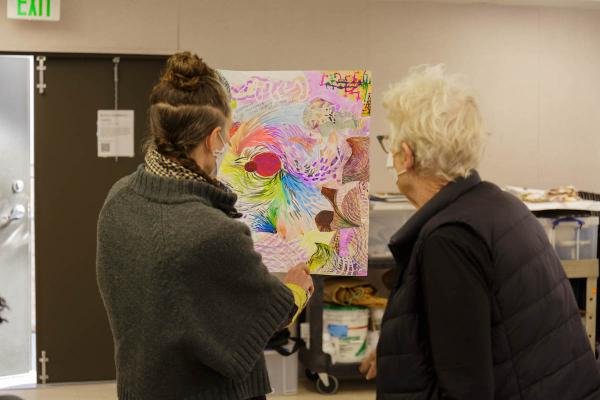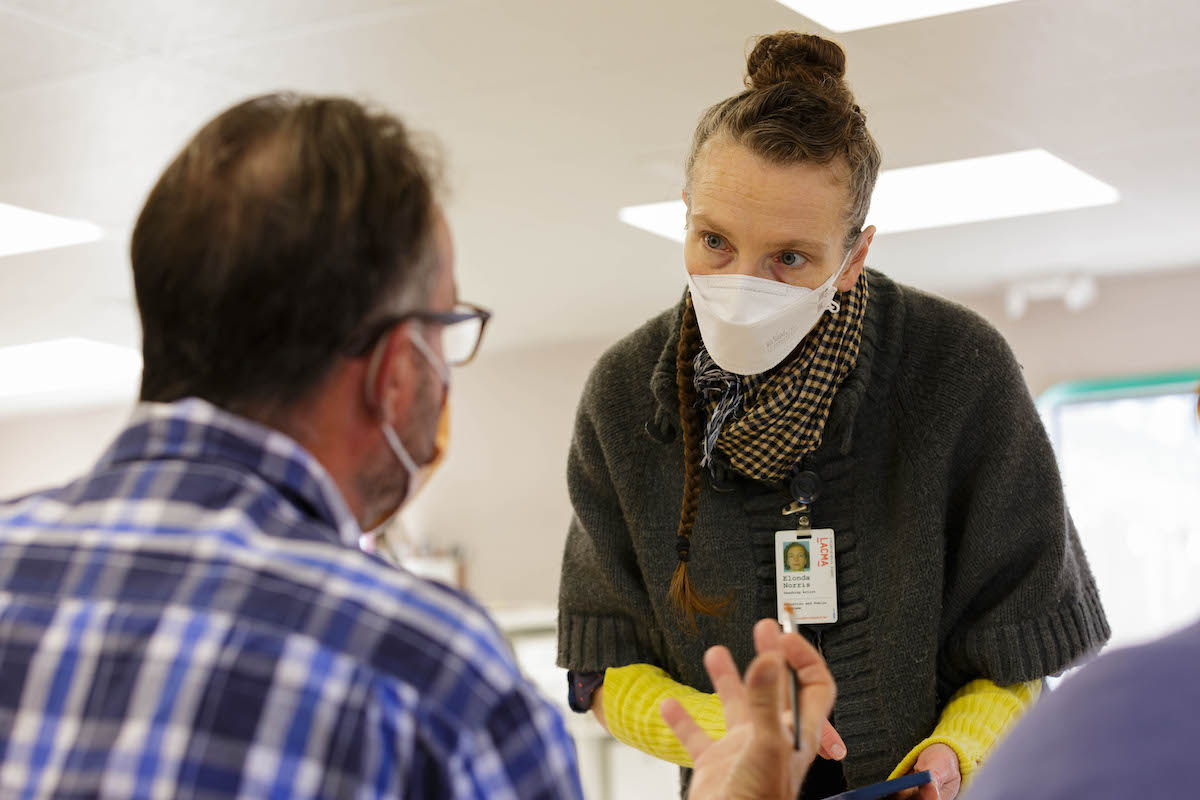In January 2023, Teaching Artist Elonda Norris taught LACMA’s Create+Collaborate class series funded by The Vitality Arts Project for Art Museums — E.A. Michelson Philanthropy. Participants joined a community of peers to learn and experimented with different mixed-media techniques such as pottery, fabric dying, drawing, sculpture, and more. Through gallery tours and art-making, Create+Collaborate became a space for inspiration, intellectual stimulation, personal reflection, and social engagement. Elonda also leads Personal Connections, in partnership with Alzheimer's LA, our regular series of engaging, fun, and free art chats for persons living with dementia or Alzheimer’s and their care partners. Through facilitated discussions online, individuals with early stage dementia or Alzheimer's disease have the opportunity to create meaningful connections with works of art. I recently had the opportunity to talk to Elonda about her experiences with these programs and working with LACMA communities.
Elonda, can you tell me about your career and what led you to being a teaching artist at LACMA?
After graduate school, I knew that I wanted to teach, to continue being involved in the spark that happens when someone encounters a new art process, medium, or artwork. Fortunately, I was able to participate in the Armory Center for the Arts Fellowship program, where I learned about different educational methods as well as getting a lot of hands-on experience. When I heard about an opportunity to lead tours at LACMA, I jumped at the chance to facilitate conversations with folks in front of the outstanding artworks in LACMA’s collection. For over 15 years now, I have been teaching in many different programs at LACMA and off-site in the public schools and community centers, yet each time is fresh. I continue to be amazed by the discoveries a class can make in front of an artwork through close looking and in the studio by being open to possibility.
Art is about relationships and making connections. We can build empathy through art. We can get into a flow—a meditative state through making art. In my own artwork, I use various materials, like household items, furniture, and food, to invite all of us to question our relationship to convenience and consumption while reaffirming our connections to each other and cultivating joy.
In addition to my teaching practice and personal art practice, I also have experience organizing exhibitions and events as a co-founder and co-curator of Summercamp’s ProjectProject, an artist-run space in El Sereno. We are currently on hiatus, but Janice Gomez, Fatima Hoang, and I programmed over 23 group exhibitions, as well as numerous events, workshops, and performances, from a pickling workshop and sound bath to residencies and a site-specific theater work, all in an eight-year span.
Can you tell us about your experience with Create+Collaborate?
Since Create+Collaborate is a class designed for older adults, students bring a wealth of experience, which contributed to fabulous conversations in the galleries and translated into hands-on knowledge in the studio. It was exciting to have students draw upon their broad backgrounds as they were experimenting with materials. Everyone had an attitude of curiosity—which led us in all kinds of fun directions. As an extension of our collage unit, we even had a guest presenter! We invited poet Brendan Constantine to help us translate our visual experience into language. Through a series of open-ended prompts and games, we generated text to use alongside our artworks as titles or to be collaged straight into the art!
Tell us about your experience in the galleries.
Being in the galleries together as a foundation of our making and our thinking was critical—especially for a mixed-media class. After teaching remotely for a number of years, and viewing artwork through a mediated screen, it was a delight to be in front of the art together—to feel the artwork’s size and lean in to examine individual brushstrokes. We ended up really being able to envision how the artist made decisions during their process. The day we looked at both Sarah Crowner’s Untitled (2016) and Ed Clark’s Untitled (1960) stands out as an example of being able to see subtle details in person that would not translate in a reproduction.
This focused looking and in-depth conversation definitely carried over into the studio. As a result of seeing bold moves in the galleries, students took risks in their own creative endeavors. Also, because we had really visualized how the artist had made their artwork, when a student would come across a stumbling block or have a process related question during their own art-making, I was not always the one to answer—another student sitting nearby would chime in with a possible solution!
Tell us about the culminating reception and art display.
The culminating art display was such an empowering celebration. We gathered for a breakfast together, then were able to spend time deeply looking at everything we had accomplished over the session together. I was impressed by how supportive everyone was of each other and encouraging of each other’s artworks, including new directions that maybe even took the artist by surprise.
What surprised you about the class and/or participants?
What was astonishing about the class was that in just five weeks, we could grow together as a community. Over the course of our conversations, both serious and playful, we developed a shared trust and rapport that normally takes much longer to develop. I think that making together—sitting side-by-side as we created our artwork—allowed us to be vulnerable and strong at the same time, which helped forge lasting relationships.
What are you looking forward to in your teaching practice?
As an educator, I value equity and inclusion. I look forward to more community building opportunities especially for older adults. Continuing to foreground artists of color, queer artists, women artists, and artists with disabilities. Seeing the radiance of discovery as students engage with art materials. I am constantly learning from my students.
To learn more about Create+Collaborate, please visit lacma.org. The next class series will be held at LACMA in November 2023. To sign up for the class contact list, please email createandcollaborate@lacma.org.
Learn more about The Vitality Arts Project for Art Museums — E.A. Michelson Philanthropy.




